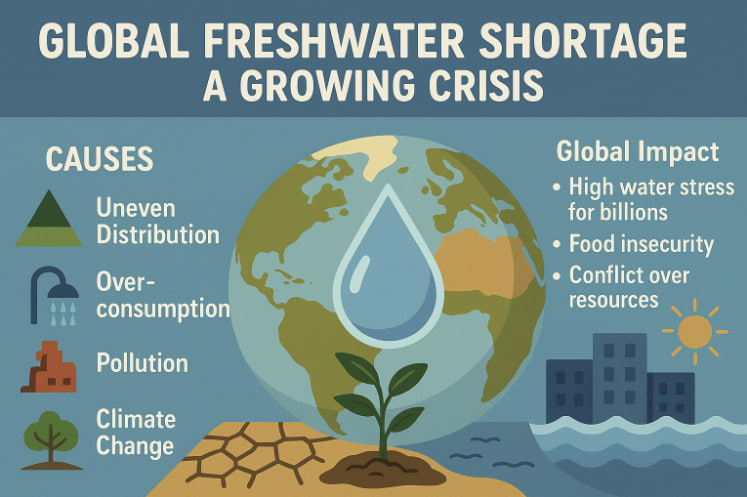Water covers over 70% of Earth’s surface, yet less than 3% of it is freshwater, and only about 1% is accessible for human use. As global populations rise and climates shift, the scarcity of clean freshwater is becoming a critical global issue—impacting health, agriculture, ecosystems, and geopolitics.
Why Is There a Freshwater Shortage?
1. Uneven Distribution
- Some regions (like the Amazon or Canada) have an abundance of freshwater, while others (like the Middle East, North Africa, and Central Asia) have very little.
- Even in water-rich countries, supplies are not always where the people are.
2. Overconsumption
- Agriculture consumes about 70% of global freshwater, often inefficiently.
- Urbanization and population growth increase domestic and industrial demand.
- Water-intensive industries (e.g., textiles, mining, energy) put pressure on local supplies.
3. Pollution
- Rivers, lakes, and aquifers are being polluted by sewage, pesticides, plastics, and industrial waste.
- Contaminated water is unsafe to drink and costly to treat.
4. Climate Change
- Rising temperatures increase evaporation and shift rainfall patterns.
- Glaciers and snowpacks, which feed rivers, are melting more quickly.
- Droughts are becoming more frequent and intense.
Global Impact of Water Scarcity
- Over 2 billion people live in countries with high water stress.
- Water scarcity leads to:
- Food insecurity due to failed crops
- Health crises from poor sanitation and waterborne diseases
- Economic instability in farming regions
- Conflict over access to rivers and aquifers
If current trends continue, by 2050, over half of the world’s population could face severe water shortages.
Solutions: What Can Be Done?
At the Government and Industry Level:
- Invest in water-efficient agriculture (drip irrigation, drought-resistant crops)
- Protect and restore wetlands and watersheds
- Improve wastewater treatment and recycling systems
- Shift to clean energy sources that use less water than fossil fuels
- Enforce pollution control laws for rivers and aquifers
- Develop desalination technology (turning seawater into freshwater)
At the Household Level:
- Use water-saving devices: low-flow toilets, efficient washers, aerated taps
- Fix leaks—a dripping tap can waste 20,000 liters per year
- Choose sustainable products that use less water in production
- Eat less water-intensive food (like processed items)
Glossary
- Freshwater — Naturally occurring water with low salt content, suitable for drinking or irrigation.
- Water stress — When demand for water exceeds available supply during a certain period.
- Aquifer — Underground layer of water-bearing rock or sediment.
- Desalination — The process of removing salt from seawater to produce freshwater.
- Drought — A prolonged period of below-average rainfall leading to water shortages.


